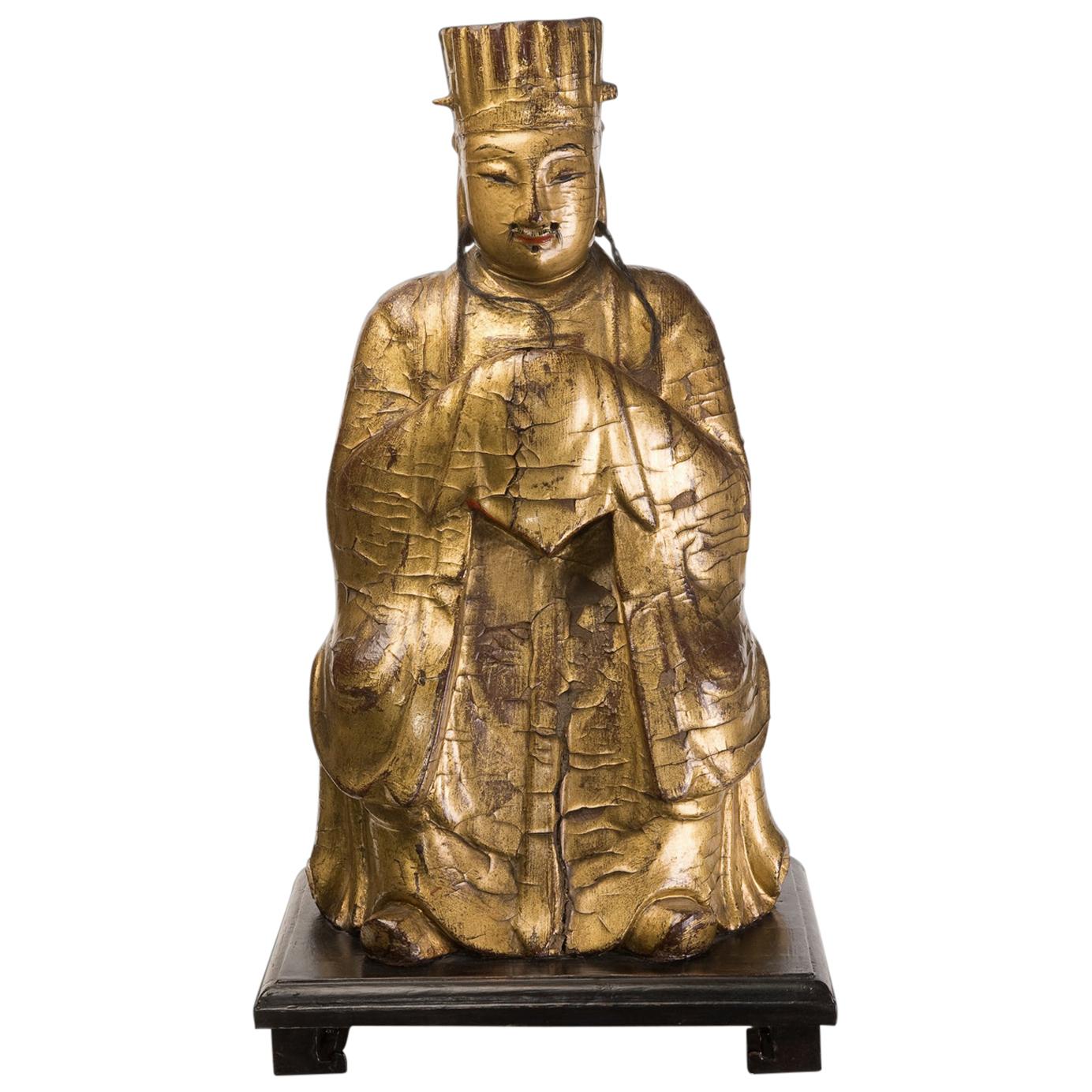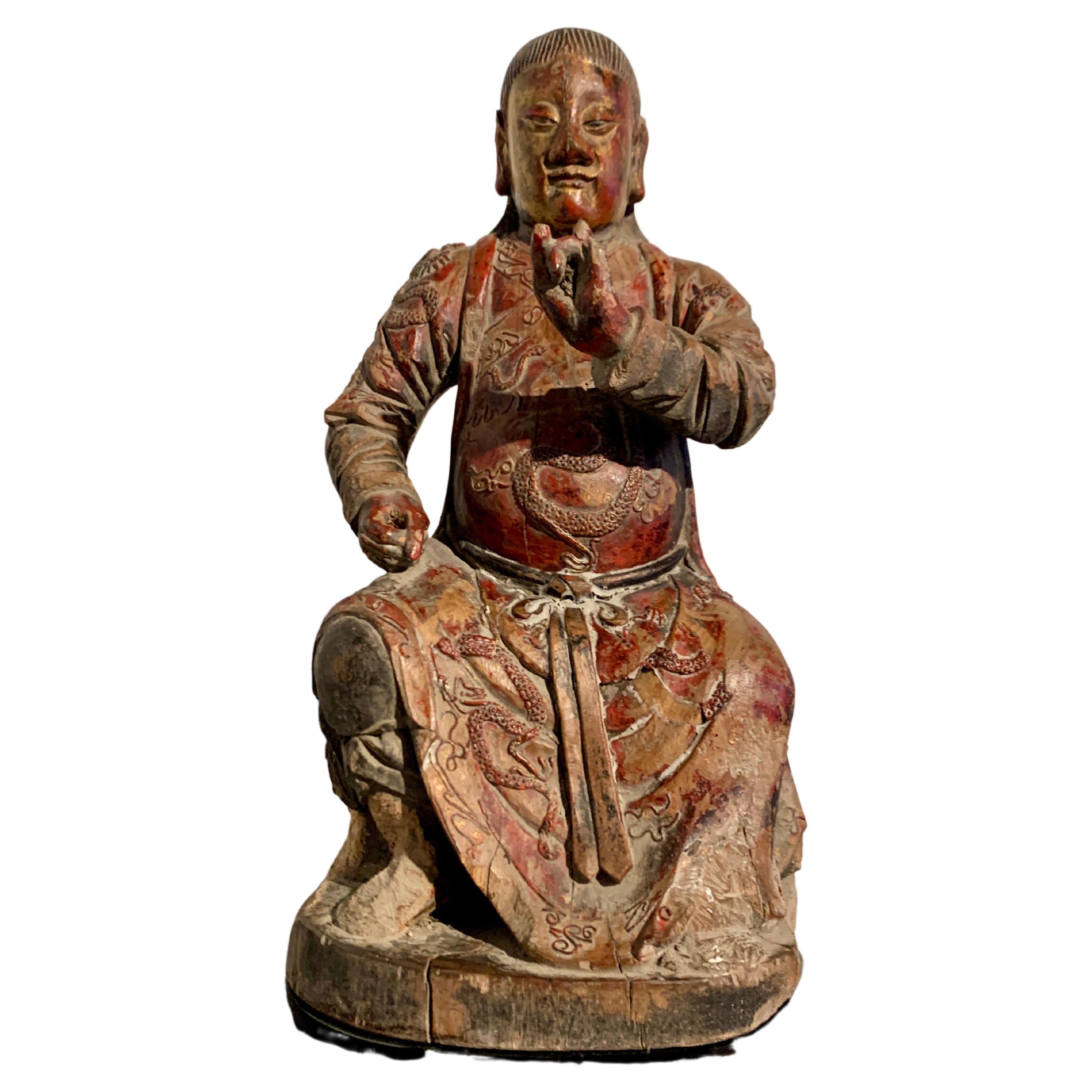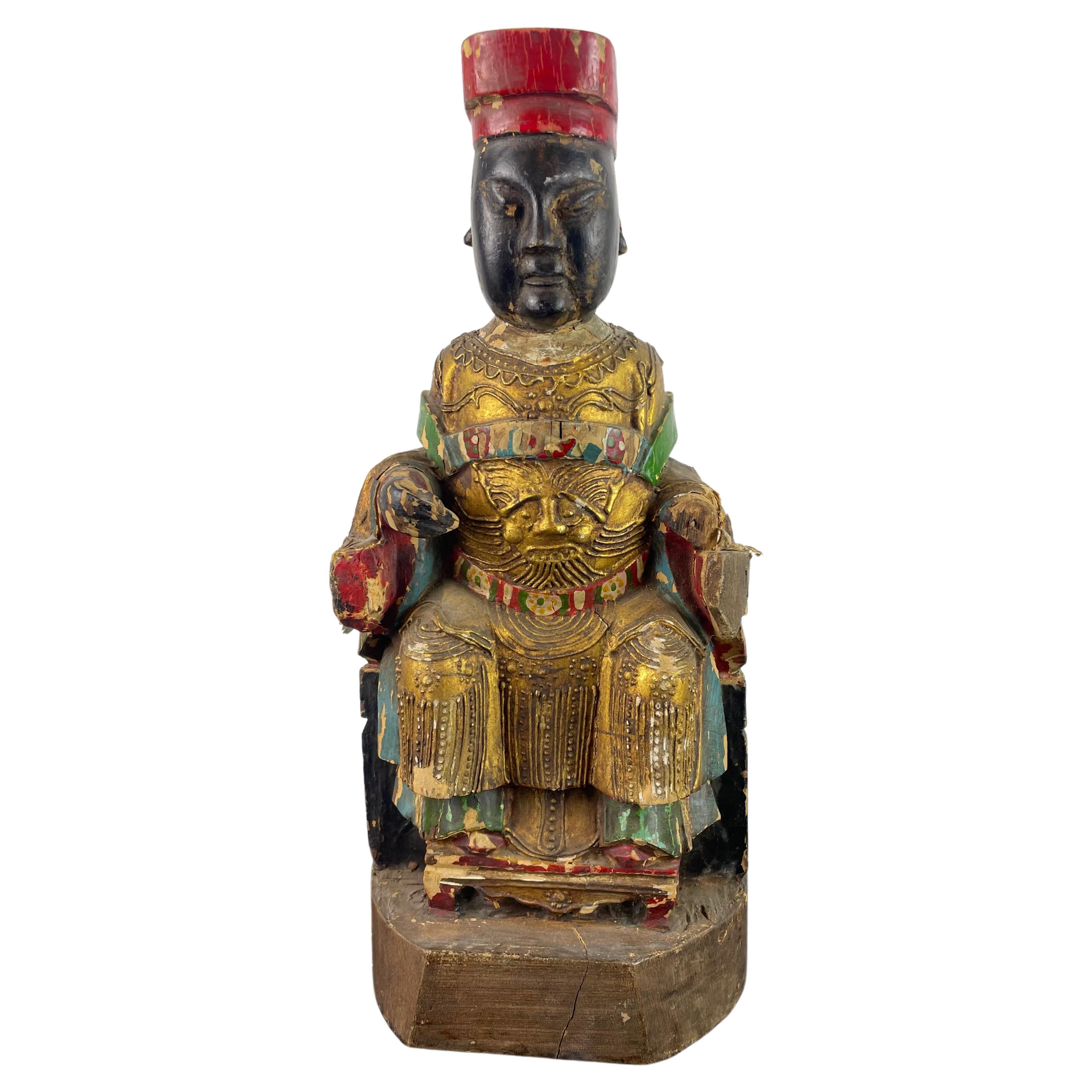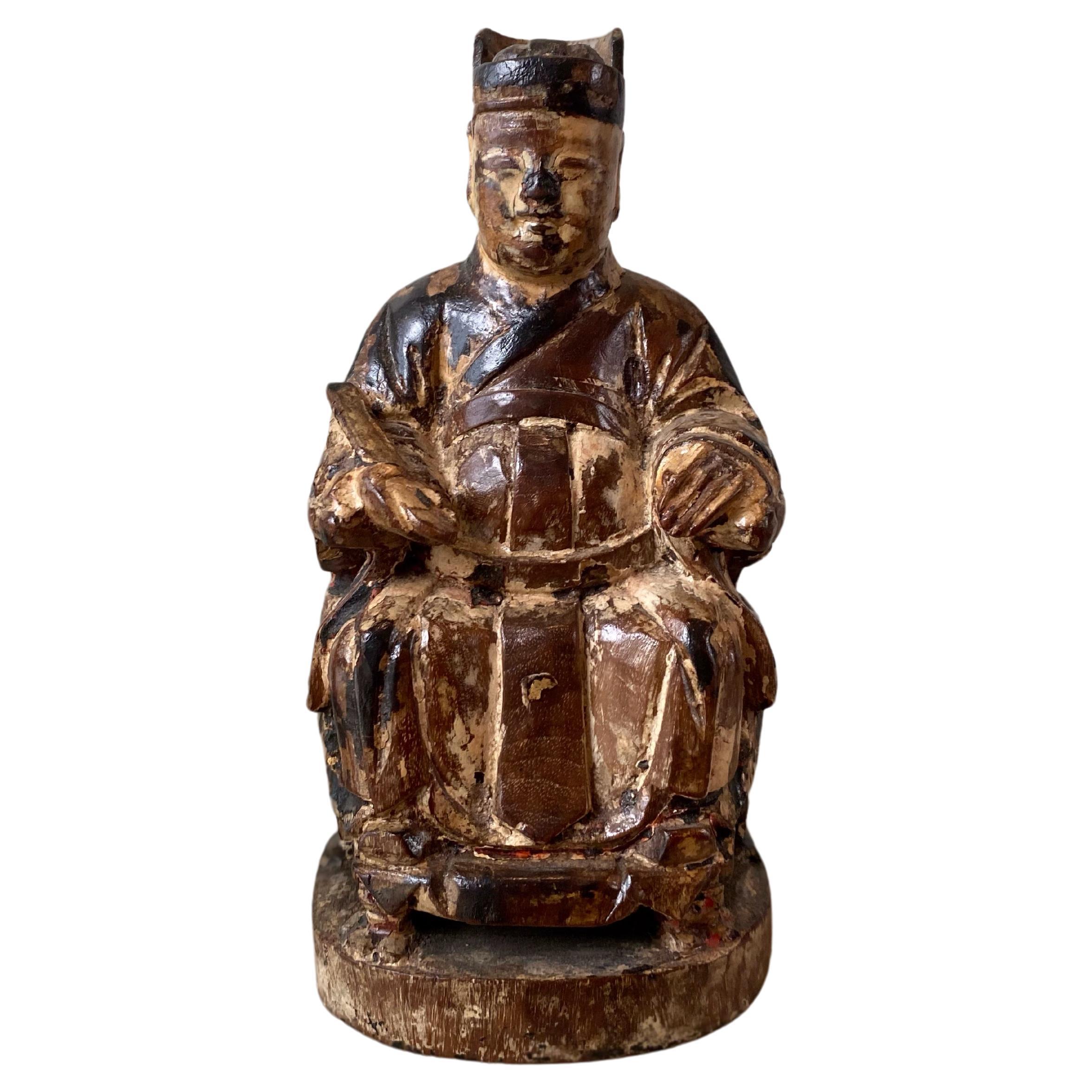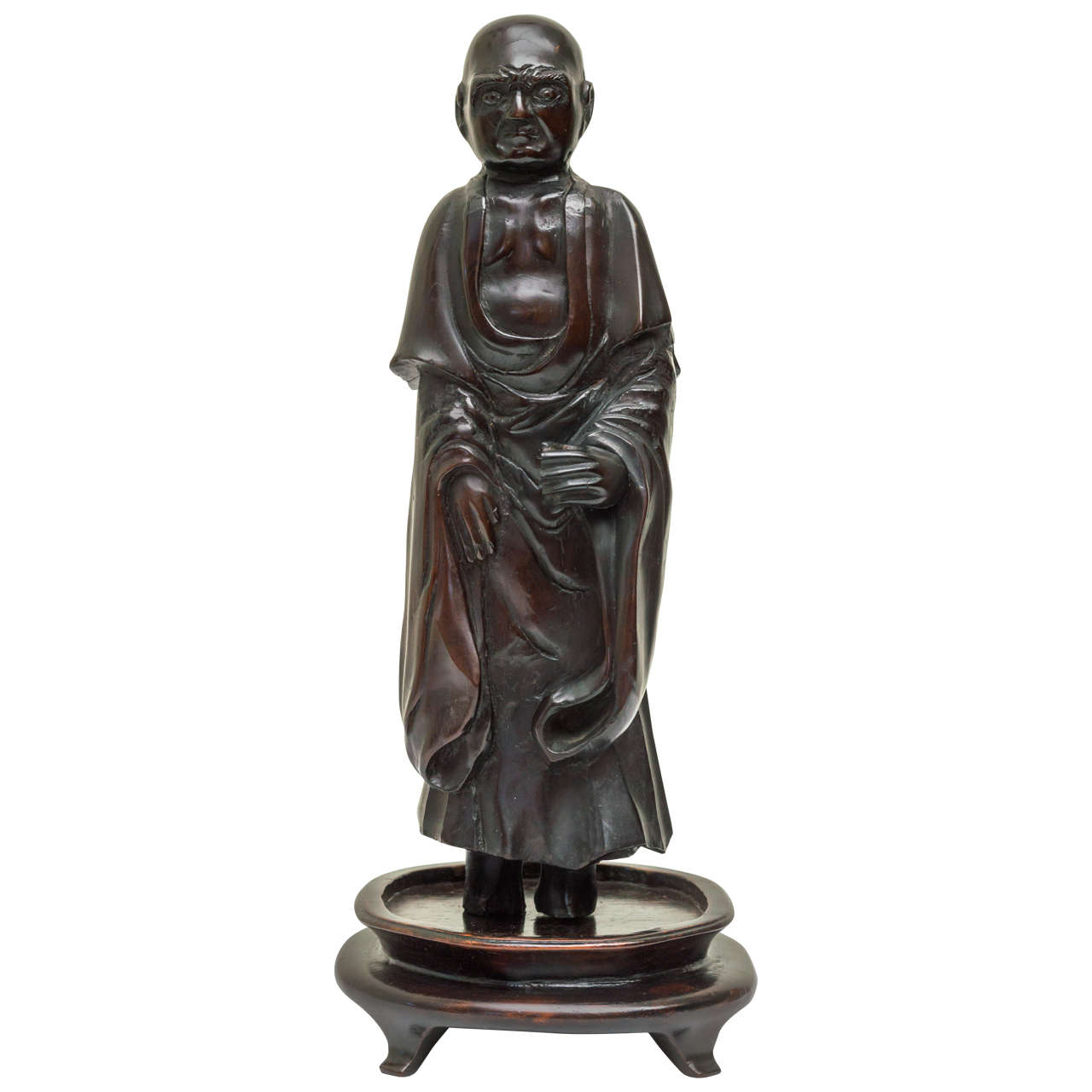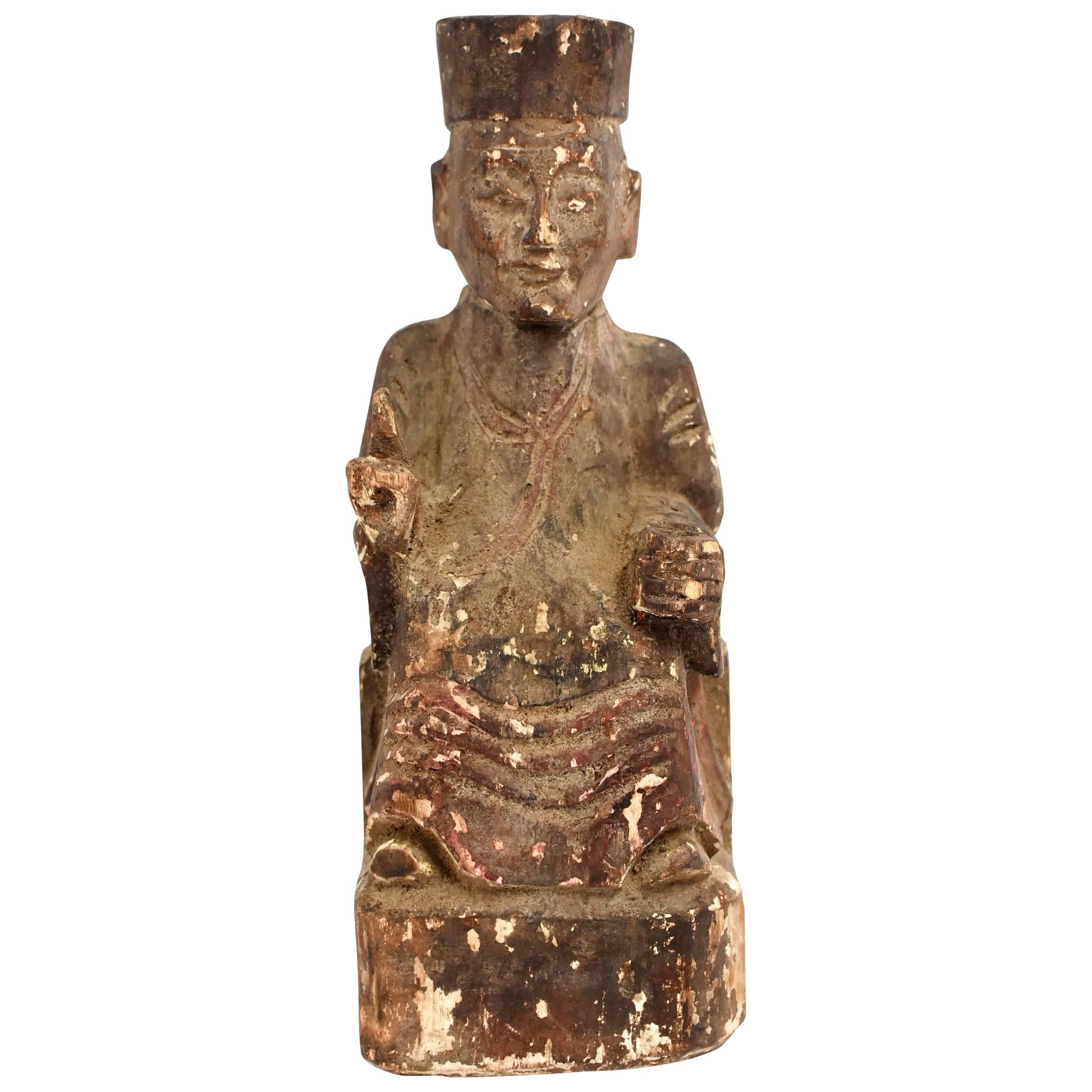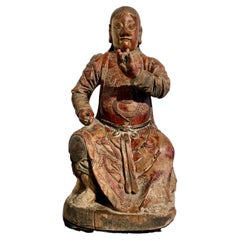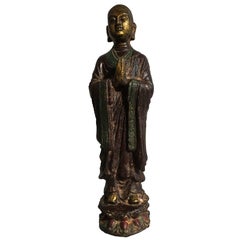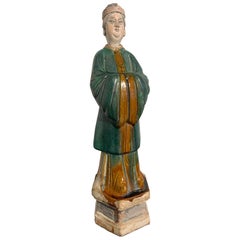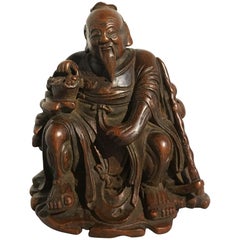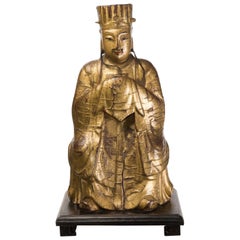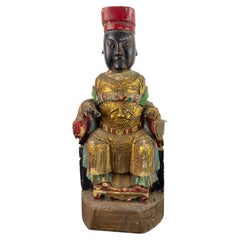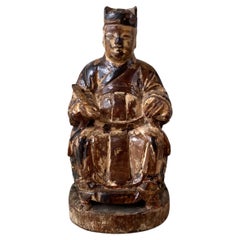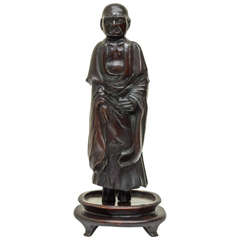Items Similar to Chinese Taoist Figure of Wenchang, Late Qing Dynasty, c. 1900, China
Want more images or videos?
Request additional images or videos from the seller
1 of 17
Chinese Taoist Figure of Wenchang, Late Qing Dynasty, c. 1900, China
$1,950
£1,478.37
€1,704.17
CA$2,746.26
A$3,045.40
CHF 1,600.13
MX$37,209.63
NOK 20,019.84
SEK 18,792.04
DKK 12,721.94
About the Item
A tall and impressive figure of the Taoist deity Wenchang Wang, carved, gessoed, lacquered, gilt and polychromed wood, Late Qing Dynasty, circa 1900, Fujian, China.
Wenchang, the Taoist deity of culture and literature, patron of authors, scholars, and students, is portrayed standing upright with his torso slightly twisted upon a tall octagonal black and red plinth decorated with a stylized lotus reserve. He is dressed as a gentleman scholar or court official, wearing heavy and sumptuous golden robes with raised leiwen (key fret) hems, and decorated with a raised dragon square to the chest. An elaborate collar with raised designs, green shoes with ruyi speed fronts, and a red official's hat, futou, upon his head complete his wardrobe.
Wenchang carries a book, one of his identifying attributes, in the crook of his arm, his hands clasped in front, hidden within the ample sleeves of his robe.
The dignified deity's face is round and benevolent. He looks outwards from almond shaped eyes over a flat nose and full, red lips.
This impressive figure has been carved from a single block of fragrant camphor wood, then gessoed, polychromed, and lacquer gilt. Raised designs on the robes, cap, and plinth created using rice paste.
Provenance:
Private California and Texas collection
Orientations, San Francisco, 1989
- Dimensions:Height: 19.25 in (48.9 cm)Width: 7 in (17.78 cm)Depth: 6.75 in (17.15 cm)
- Style:Qing (Of the Period)
- Materials and Techniques:
- Place of Origin:
- Period:1900-1909
- Date of Manufacture:circa 1900
- Condition:Wear consistent with age and use. Minor losses. Minor fading. Minor losses to the gesso, lacquer, pigments, and gilding, as seen in photos. Possible missing hanging element to the back of the hat.
- Seller Location:Austin, TX
- Reference Number:1stDibs: LU894740533022
About the Seller
5.0
Gold Seller
Premium sellers maintaining a 4.3+ rating and 24-hour response times
Established in 2001
1stDibs seller since 2010
347 sales on 1stDibs
Typical response time: 1 hour
- ShippingRetrieving quote...Shipping from: Austin, TX
- Return Policy
Authenticity Guarantee
In the unlikely event there’s an issue with an item’s authenticity, contact us within 1 year for a full refund. DetailsMoney-Back Guarantee
If your item is not as described, is damaged in transit, or does not arrive, contact us within 7 days for a full refund. Details24-Hour Cancellation
You have a 24-hour grace period in which to reconsider your purchase, with no questions asked.Vetted Professional Sellers
Our world-class sellers must adhere to strict standards for service and quality, maintaining the integrity of our listings.Price-Match Guarantee
If you find that a seller listed the same item for a lower price elsewhere, we’ll match it.Trusted Global Delivery
Our best-in-class carrier network provides specialized shipping options worldwide, including custom delivery.More From This Seller
View AllChinese Carved and Lacquered Figure of Zhenwu, Qing Dynasty, 19th century, China
Located in Austin, TX
A powerful Chinese figure of the Taoist diety Zhenwu (Xuanwu), carved and lacquered wood with applied lacquer details, Qing Dynasty, 19th century or earlier, China.
Zhenwu, also kno...
Category
Antique 19th Century Chinese Qing Sculptures and Carvings
Materials
Wood, Hardwood
Ming Dynasty Polychrome Lacquer and Gilt Iron Figure of Ananda
Located in Austin, TX
Ananda is portrayed in a typical fashion, as a youthful monk with a shaved head and dressed in simple robes. He stands upon a double lotus pedestal with hands clasped in front of him...
Category
Antique 16th Century Chinese Ming Sculptures and Carvings
Materials
Iron
Chinese Ming Dynasty Glazed Tall Attendant Figure, 16th-17th Century, China
Located in Austin, TX
A tall Chinese green and amber glazed figure of an attendant, Ming Dynasty, 16th-17th century, China.
The figure stands upon an integral plinth, dressed in long robes...
Category
Antique 17th Century Chinese Ming Sculptures and Carvings
Materials
Pottery
Chinese Carved Bamboo Figure of a Sage, Qing Dynasty, 18th Century
Located in Austin, TX
A sweet and lovely Chinese bamboo carving of the sage Dongfang Shuo, mid-Qing dynasty, 18th century, China.
Well carved form a single section o...
Category
Antique 19th Century Chinese Qing Sculptures and Carvings
Materials
Bamboo
Chinese Carved Boxwood Figure of Guanyin, Mid-Qing Dynasty
Located in Austin, TX
A sublime Chinese carved boxwood figure of the Bodhisattva of Compassion, Avalokiteshvara, called Guanyin in Chinese, mid-Qing dynasty.
The an...
Category
Antique Late 18th Century Chinese Qing Sculptures and Carvings
Materials
Boxwood
Chinese Carved Zitan Figure of a Bodhisattva, Qing Dynasty
Located in Austin, TX
A finely carved Chinese zitan wood figure of an unidentified bodhisattva, possibly Guanyin, late Qing Dynasty, circa 1900, China.
The androgynous figure has a plump, almost matronly face, with downcast eyes and a gentle smile. The hair in long tresses, gathered and tied in a high chignon.
The enlightened being is portrayed seated in dhyanasana, bare feet resting on crossed legs, both soles pointing up.
Thick robes billow and drape around the full figured body. The hands display...
Category
Early 20th Century Chinese Qing Sculptures and Carvings
Materials
Lapis Lazuli
You May Also Like
Chinese Dignatary Figure in Gilded and Painted Wood, 18th Century
Located in Saint-Ouen, FR
Chinese Dignatary figure in gilded and painted wood.
18th century.
On a modern wood base.
Category
Antique 18th Century Chinese Antiquities
Materials
Giltwood
Taoist dignitary statue - ancestor reliquary - lacquered wood - China Qing 19th
Located in Beuzevillette, FR
Superb old Taoist statue in polychrome and gold lacquered wood, representing a Dignitary seated on a throne, armchair. It is carved from solid wood, with...
Category
Antique Early 19th Century Chinese Qing Antiquities
Materials
Wood
Early 20th Century Kitchen God Deity Statue
Located in Singapore, SG
A handsome wooden figure of the Kitchen God (灶神 in Chinese, pronounced zào shén), the Chinese name can also be translated into Stove God. He is a popular a...
Category
Early 20th Century Chinese Qing Sculptures and Carvings
Materials
Sandalwood
Early 18th Century Chinese Qing Period Carved Lohan Figure
Located in San Francisco, CA
Early 18th century Chinese Qing period carved Lohan figure in draped robes. Very finely carved heavy dark rosewood. The aged surface patina with tight gra...
Category
Antique Early 18th Century Chinese Qing Sculptures
Materials
Rosewood
19th Century Taoist Master Wood Statue
Located in Somis, CA
Very old solid wood statue depicts the Taoist Zen Master. He wears typical Tao robe and hat, with two fingers pointing up, and the left hand on his knee. Su...
Category
Antique Early 19th Century Chinese Sculptures and Carvings
Materials
Wood
19th Century Chinese Figure of a Guardian God
Located in Somis, CA
This 19th-century hand-carved polychromatic wood figure depicts a powerful Guardian, poised on a recumbent tiger with his right fist raised in a striking motion, his eyes bulging wit...
Category
Antique Early 19th Century Chinese Sculptures and Carvings
Materials
Wood
More Ways To Browse
Hand Clasp
Chinese Sleeves
Chinese Clasp
Chinese Head Sculpture
Chinese Antique Book
Antique Chinese Robe
Chinese Qing Figure
Chinese Collar
Octagon China
Chinese Plinth
Antique Chinese Hats
Chinese Taoist
Carved Chinese Chests
Asian Dragon Sculpture
Lacquered Octagon
Chinese Dragon Head
Antique Chinese Lacquer Chest
Chinese Painted Chest
